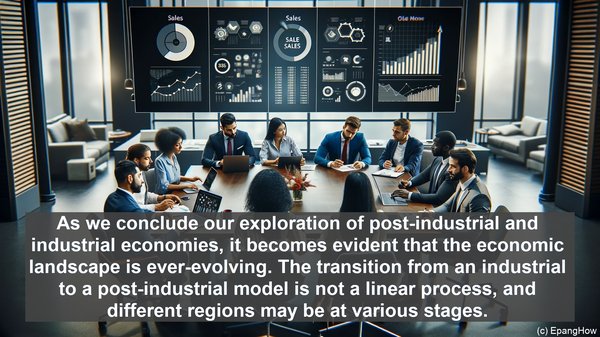Introduction: The Evolution of Economies
Hello everyone! Today, we’re diving into the fascinating realm of economics, specifically exploring the transformation from industrial to post-industrial economies. Over the years, economies have undergone significant changes, and understanding these shifts is crucial to comprehend the dynamics of the modern world.
Defining Industrial Economies: The Age of Manufacturing
Industrial economies, often associated with the 19th and 20th centuries, were characterized by extensive manufacturing and production. These economies thrived on the mass production of goods, with factories and assembly lines becoming the backbone of industries. Key sectors included manufacturing, mining, and agriculture. The focus was on efficiency, scale, and standardization, with the aim of meeting the rising demands of a growing population.
The Post-Industrial Shift: A Paradigm Change
The advent of the post-industrial economy marked a significant departure from the manufacturing-centric model. Post-industrial economies are driven by the service sector, with a greater emphasis on knowledge, information, and technology. While manufacturing still exists, it is often more automated and technologically advanced. The rise of sectors like finance, IT, healthcare, and professional services has been a hallmark of post-industrial economies.

Key Characteristics of Post-Industrial Economies
Post-industrial economies exhibit several distinct features. Firstly, there is a greater reliance on intellectual capital, with highly skilled professionals playing a crucial role. Secondly, innovation and research are paramount, as these economies thrive on new ideas and technologies. Thirdly, flexibility and adaptability are essential, given the rapid pace of change. Lastly, the service sector, including areas like finance, education, and entertainment, assumes a more prominent position.
Implications and Challenges of the Post-Industrial Era
The shift to a post-industrial economy has brought about both opportunities and challenges. On the positive side, there is a greater focus on knowledge and creativity, leading to the development of cutting-edge technologies and solutions. However, there are also concerns, such as job polarization, where certain roles become obsolete, while others requiring specialized skills are in high demand. Additionally, the reliance on technology can lead to issues like data privacy and cybersecurity.
The Continuing Relevance of Industrial Economies
While post-industrial economies have gained prominence, it is important to note that industrial economies still play a vital role. In many regions, manufacturing remains a significant contributor to GDP and employment. Moreover, certain industries, such as heavy machinery and construction, are inherently linked to the industrial model. The key lies in striking a balance between the two paradigms, leveraging the strengths of each.

